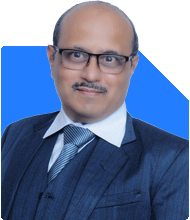Should I quit my job and move to Ranchi at 42 with 70 lakh in MF?
Ramalingam Kalirajan |10893 Answers |Ask -Follow
Mutual Funds, Financial Planning Expert - Answered on Jan 31, 2025
He has an MBA in finance from the University of Madras and is a certified financial planner.
He is the director and chief financial planner at Holistic Investment, a Chennai-based firm that offers financial planning and wealth management advice.... more

I am 42 staying in Pune with my wife and two daughters 7 years and 1 year old. I have 70 lakh in MF , 12 lakh in nps, 18 lakh in pf and 31 lakh in stocks. I have additional investment in 62 lakh in FD that is pledged to trade in derivatives through a consultant. Wife has physical gold worth 5 lakh. I have recently bought a land on loan and current liability is 25 lakh @8.5% ( total 70(land+construction)lakh is sanctioned for construction). My current expense is 1 lakh a month and i stay in rented house. My monthly income is 2.5 lakh from salary. Can I quit my job and move to my hometown in Ranchi. What is the financial plan if i want to quit.
Current Financial Position
Rs. 70 lakh in mutual funds.
Rs. 12 lakh in NPS.
Rs. 18 lakh in PF.
Rs. 31 lakh in stocks.
Rs. 62 lakh in FD (pledged for derivatives trading).
Rs. 5 lakh in wife’s gold.
Rs. 25 lakh loan at 8.5% interest (out of Rs. 70 lakh sanctioned).
Monthly salary of Rs. 2.5 lakh.
Monthly expenses of Rs. 1 lakh.
Staying in a rented house.
Key Challenges in Quitting Job
You need a stable income source after quitting.
Loan repayment should not burden your finances.
Derivatives trading involves high risk.
Relocation to Ranchi should not disrupt financial stability.
Step-by-Step Financial Plan
1. Build a Strong Emergency Fund
Keep Rs. 20 lakh as a buffer for 2 years of expenses.
Use FD or liquid mutual funds for this.
This ensures financial security after quitting.
2. Secure a Passive Income Source
You need at least Rs. 1 lakh per month in passive income.
This can come from investments, consulting, or business.
Rental income or dividends alone may not be enough.
3. Restructure Your Loan
Your land loan at 8.5% interest adds financial pressure.
Repaying Rs. 25 lakh from FD or stocks reduces the burden.
Avoid using risky derivative profits to pay loans.
4. Reallocate Investments for Stability
Reduce exposure to high-risk derivatives trading.
Convert Rs. 62 lakh FD into a mix of mutual funds and bonds.
Equity mutual funds can generate higher long-term returns.
5. Plan for Child’s Future
Your daughters are 7 years and 1 year old.
Set aside Rs. 25 lakh for education in safe investments.
Avoid blocking funds in low-return FDs.
6. Address Housing Needs
If moving to Ranchi, consider staying in a rented house initially.
Construction should not strain your savings.
Use part of your investments if you decide to build.
Final Insights
Quitting your job is possible but needs careful planning.
Ensure passive income before quitting.
Clear high-interest liabilities to reduce stress.
Invest wisely for long-term financial security.
Moving to Ranchi should not affect your financial freedom.
Consult a Certified Financial Planner for proper execution.
Best Regards,
K. Ramalingam, MBA, CFP
Chief Financial Planner
www.holisticinvestment.in
https://www.youtube.com/@HolisticInvestment
You may like to see similar questions and answers below
Ramalingam Kalirajan |10893 Answers |Ask -Follow
Mutual Funds, Financial Planning Expert - Answered on May 05, 2024
Ramalingam Kalirajan |10893 Answers |Ask -Follow
Mutual Funds, Financial Planning Expert - Answered on Jun 06, 2024
Nitin Narkhede | Answer |Ask -Follow
MF, PF Expert - Answered on Sep 24, 2024
Milind Vadjikar | Answer |Ask -Follow
Insurance, Stocks, MF, PF Expert - Answered on Oct 02, 2024
Ramalingam Kalirajan |10893 Answers |Ask -Follow
Mutual Funds, Financial Planning Expert - Answered on Oct 22, 2024
Ramalingam Kalirajan |10893 Answers |Ask -Follow
Mutual Funds, Financial Planning Expert - Answered on Dec 15, 2025
Ramalingam Kalirajan |10893 Answers |Ask -Follow
Mutual Funds, Financial Planning Expert - Answered on Dec 15, 2025
Radheshyam Zanwar |6746 Answers |Ask -Follow
MHT-CET, IIT-JEE, NEET-UG Expert - Answered on Dec 15, 2025
Ramalingam Kalirajan |10893 Answers |Ask -Follow
Mutual Funds, Financial Planning Expert - Answered on Dec 15, 2025
Ramalingam Kalirajan |10893 Answers |Ask -Follow
Mutual Funds, Financial Planning Expert - Answered on Dec 15, 2025
Ramalingam Kalirajan |10893 Answers |Ask -Follow
Mutual Funds, Financial Planning Expert - Answered on Dec 15, 2025
Samraat Jadhav |2508 Answers |Ask -Follow
Stock Market Expert - Answered on Dec 15, 2025
Ramalingam Kalirajan |10893 Answers |Ask -Follow
Mutual Funds, Financial Planning Expert - Answered on Dec 15, 2025
Reetika Sharma |425 Answers |Ask -Follow
Financial Planner, MF and Insurance Expert - Answered on Dec 15, 2025
Radheshyam Zanwar |6746 Answers |Ask -Follow
MHT-CET, IIT-JEE, NEET-UG Expert - Answered on Dec 15, 2025

























